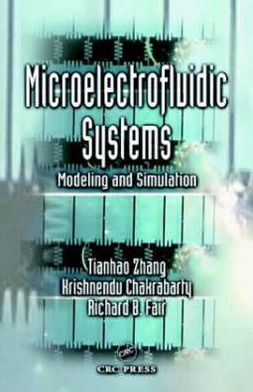Microelectrofluidic Systems: Modeling and Simulation
Composite systems that integrate microelectromechanical and microelectrofluidic (MEF) components with electronics are emerging as the next generation of system-on-a-chip (SOC) designs. However, there remains a pressing need for a structured methodology for MEFS design automation, including modeling techniques and simulation and optimization tools.\ Integrating top-down and bottom-up design philosophies, Microelectrofluidic Systems presents the first comprehensive design strategy for MEFS....
Search in google:
Composite systems that integrate microelectromechanical and microelectrofluidic (MEF) components with electronics are emerging as the next generation of system-on-a-chip (SOC) designs. However, there remains a pressing need for a structured methodology for MEFS design automation, including modeling techniques and simulation and optimization tools.Integrating top-down and bottom-up design philosophies, Microelectrofluidic Systems presents the first comprehensive design strategy for MEFS. This strategy supports hierarchical modeling and simulation from the component level to the system level. It leads to multi-objective optimization tools valuable in all phases of the design process, from conceptualization to final manufacturing. The authors begin by defining the basic variables and elements needed to describe MEFS behavior, then model that behavior across three layers of abstraction: the low-level component, high-level reconfigurable architecture, and bio/chemical application layers. They have developed a hierarchical integrated design environment with SystemC and present its architecture and associated functional packages.Microelectrofluidic Systems is visionary in its leverage of electronic design principles for microsystem design and heralds a new era of automated SOC design. The strategy it presents holds the potential for significant reductions in design time and life-cycle maintenance costs, and its techniques and tools for robust design and application flexibility can lead to the high-volume production needed for the inevitably growing product market. Booknews Based on a research project at Duke University, this monograph presents an integrated approach to the hierarchical modeling, simulation, and design of microelectrofluidic systems (MEFS) used for automated drug dispensing and microchemical analysis. The simulation methodology combines a high-level stochastic queuing network approach with low-level nodal conservative differential equations. The design optimization algorithms utilize the Taguchi robust design method and the statistical response analysis method. The final chapter compares the performance of continuous-flow systems and droplet-based systems for performing polymerase chain reactions. Annotation c. Book News, Inc., Portland, OR (booknews.com)
PrefaceList of FiguresList of Tables1Introduction11.1Modeling and Simulation Issues21.2Modeling and Simulation Needs62Hierarchical Modeling152.1MEFS Dynamic Modeling and Simulation at Circuit Level162.2MEFS System-level Modeling and Simulation313SystemC-based Hierarchical Design Environment393.1Suitability of Modeling Languages for Hierarchical Design413.2Building Design Environment with SystemC664System-level Simulation and Performance Evaluation754.1MEFS Computing and Architecture764.2Hierarchical Modeling and Simulation Methodology864.3Micro-Chemical Handling System894.4System Performance Analysis and Design Optimization1005Circuit-level Optimization1095.1Simulation Design Methodology1105.2Optimization Verification1275.3On-target Design Optimization1305.4Robust Design Optimization1425.5Application Flexibility Optimization1666Performance Evaluation1836.1Introduction1846.2Continuous-flow PCR System1886.3Droplet-based PCR System2066.4Comparison between Continuous-flow PCR and Droplet PCR2126.5Scheduling of Microfluidic Operations for Reconfigurable Two-Dimensional Electrowetting Arrays2167Conclusion233AVHDL Queuing Model237BHierarchical Environment with SystemC239References243Index255
\ From The CriticsBased on a research project at Duke University, this monograph presents an integrated approach to the hierarchical modeling, simulation, and design of microelectrofluidic systems (MEFS) used for automated drug dispensing and microchemical analysis. The simulation methodology combines a high-level stochastic queuing network approach with low-level nodal conservative differential equations. The design optimization algorithms utilize the Taguchi robust design method and the statistical response analysis method. The final chapter compares the performance of continuous-flow systems and droplet-based systems for performing polymerase chain reactions. Annotation c. Book News, Inc., Portland, OR (booknews.com)\ \








